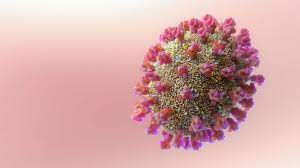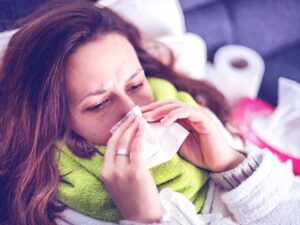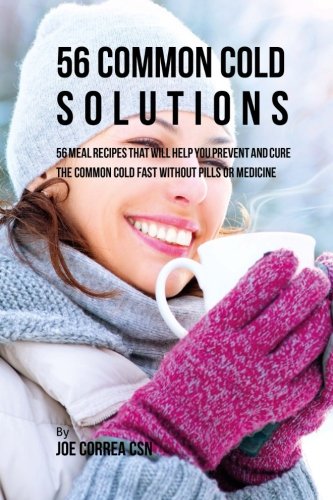The common cold is a viral infection which is a disease of the upper respiratory tract.
The common cold affects the nose, throat, sinuses, and larynx. The common cold is also known as nasopharyngitis, viral rhinitis, acute coryza, and rhinopharyngitis. The common cold is associated with a number of viruses such as rhinovirus, parainfluenza viruses, etc. Colds are more common in the winter season and spring seasons but can get cold at any time. It is very common and generally clears up on its own within a week or two weeks.
COMMON COLD SYMPTOMS:
The symptoms may develop within a few days after exposure/infection with the virus. Symptoms may last for 10-14 days. The main symptoms include,
• Sneezing
• Stuffy nose(nasal congestion)
• Runny nose
• Dry or sore throat
• Mucus dripping from nose
• Watery eyes
• Coughing
• Fever
• Tiredness
• Body aches
• Sometimes loss of smell and taste
• Earache
• Loss of appetite
• Mild fatigue
COMMON COLD IS CAUSED BY:
There are many types of viruses (about 200) that can cause a common cold,
rhinoviruses are the main cause of the common cold.
How did it cause?
• When the virus (which is responsible for the common cold) enters the body through the nose or mouth sometimes the eyes.
• The virus will bind to the particular receptor (ICAM -1 ) present in the respiratory epithelial cells which in turn causes the release of inflammatory mediators. These mediators then produce the symptoms.
How does a cold spread?
Common cold can spread through either by direct contact or by indirect contact.
1. Direct contact: through sneezing or by coughing, the tiny droplets of fluid
containing the cold virus are out and launched into the air and can be breathed by
other
2. Indirect contact: Sneeze onto a door handle or something else and when someone touches the handle a few minutes later, they catch the cold virus if they touch their mouth or nose.
RISK FACTORS OF THE COMMON COLD:
Many factors can increase the catching of colds including,
1. Close contact with someone, who is suffering from a common cold.
2. Age: children under the age of 6 are more prone to the common cold because their
immune systems haven’t matured enough so, resistance will develop for many types of viruses. Children who don’t frequently careful about washing their hands after sneezing.
3. Seasons: many people will catch a common cold during the winter season. During the rainy season, bacteria float in the air and can be breathed by others. In the summer season, the mucus membrane will get dry and causing an itchy throat and dry nose.
4. smoking: smoking disrupt the immune system. This raises the risk of catching a cold. Inhaling tobacco smoke can irritate the throat lining since it consists of toxic chemicals.
5. stress: stress makes the body vulnerable to getting a cold more often because the stress makes the person mentally and physically much tired that time body is not able to control the attack of the virus.
6. weak immune system: as age developed, immunity will decrease which causes the common cold.
COMPLICATIONS OF THE COMMON COLD:
The complications of the common cold include,
1. Asthma: cold can trigger wheezing. So, a person who is suffering from
asthma, or a cold can make it worse.
2. COPD (coronary Obstructive pulmonary disease)
3. chest infections
4. strep throat
5. Bronchiolitis
6. Acute ear infection: This will occur when the virus or the bacteria enters the space behind the eardrum. The symptoms of this infection is a fever following a
common cold.
7. Pneumonia
8. Acute sinusitis: inflammation and swelling of the sinuses.
PREVENTION OF COMMON COLD:
• Wash hands regularly with soap and water at least 20-30 seconds
• Disinfectant contaminated objects and surfaces
• Reduce stress
• Do regular exercise that helps to boost the immune system and speed recovery
form the illness
• Drink more water
• Get enough sleep
• Eat healthy foods
• Always try to cover your mouth and nose when sneezing and coughing
• Isolate yourself until symptoms have passed
• Avoid close contact with people who are suffering from a common cold or other upper respiratory tract infections (URTI)
• Don’t smoke and avoid second-hand smoking
• Take a warm shower daily which helps to keep clear sinuses
• Avoid touching your face with unwashed hands
DIAGNOSIS OF COMMON COLD:
There are no lab tests that are available to diagnose colds though they are primarily diagnosed based on symptoms and physical examination.
• Physical exam: physical exam is done to determine whether the patient is experiencing a cold or not by asking the questions like when they started. How severe are they? Etc. They will check the body temperature and evaluate the lungs. During the physical examination, the doctor will pay more attention to the chest, neck, head, etc. They will examine if a bacteria that helps to source is causing the illness or not.
COMMON COLD TREATMENTS:
There is no treatment a cure for the common cold. It will get better on its own.
Antibiotics won’t help in the treatment of colds because antibiotics are used for bacterial infections, not for viral infections.
There are some treatments which make you feel better includes,
• Getting lots of rest: which saves the energy to let the virus run its course.
• Drinking plenty of water: which hydrates the body by replacing the fluids and
relieving nasal congestion.
• Gargling: Gargling with warm salt water helps to clear the throat and reduce
irrigation.
• Use nasal spray or nasal drops: helps to relieve from nasal congestion
• Vapour rub: Topical dosage from which open the airways
• Zinc lozenges: reduce the duration of a cold.
• Avoid alcohol and Caffeine
• Stop smoking
• Echinacea: which helps to reduce the duration of a cold by reducing the symptoms. Also, boost the immune system which fights against viral infections.
Medication:
Over-the-counter medicines and cold and cough medicines may help cure the symptoms in adults and Older children.
1. Nasal decongestants: These are the class of medication that is used for the treatment of nasal congestion (nose blockage)
2. Analgesics: a class of drugs That reduce the pain
Click Here To Buy
COMMON COLD MEDICINE:
Antibiotics: Azithromycin, Amoxicillin, etc
Antiallergic: Levocetirizine, Montelukast, Fexofenadine, etc
Common cold tablet name
tablet Azee 500 mg daily one time or tablet clavam 625 mg daily three tome
tablet monetary Lc daily night.



